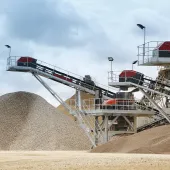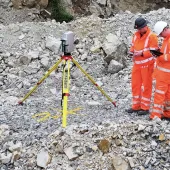Quarries & Nature 2017

MPA celebrates the industry’s restoration and biodiversity achievements at The Royal Society
MINERAL Products Association (MPA) members are planning to increase the area of priority habitats on restored sites from 6,000ha currently to around 9,000ha in coming years, and increase the length of hedgerows planted from 79km to 237km. The area of priority habitat would then be equivalent to the size of Cardiff, whilst the hedgerows, if laid end to end, would stretch from London to Cardiff.
This was the background to the MPA’s ‘Quarries & Nature 2017 – Appreciating Assets’ event, presented by BBC Radio 4’s Farming Today presenter, Sybil Ruscoe, on Thursday 19 October at The Royal Society, London.
The event attracted 45 environmental and conservation organizations as well as industry operators to celebrate the industry’s contribution to nature conservation. Expert speakers included Stephanie Hilborne OBE, chief executive of The Wildlife Trusts, Professor Steve Ormerod, Cardiff Professor of Ecology and until recently chairman of the RSPB, and Tom Butterworth, associate director of WSP.
The event showcased some of the best examples of quarry restoration and wildlife conservation anywhere in Europe, which had been entered for the MPA Restoration Awards and the MPA Biodiversity Awards in association with Natural England. A series of outstanding images were also presented as part of the MPA’s Nature Photo competition.
The MPA also launched Quarrywatch, which will link into the nationwide round of BioBlitz events being planned around the country during 2018 and will involve focused nature surveys at designated locations to gain a picture of the species colonizing restored quarries and other nature sites. Local wildlife groups, individual enthusiasts and schools will also be invited to take part in the initiative.
The tenth anniversary of the partnership programme Nature After Minerals (NAM) was also celebrated at the event.
Nigel Jackson, chief executive of the MPA, said: ‘Once again, MPA members have demonstrated what an environmentally responsible industry can do to both protect existing and create new habitats. We could not be more proud to showcase what can be achieved by an industry that is uniquely placed to make a net gain to biodiversity.’
Stephanie Hilborne, said: ‘Working together, the minerals sector and nature conservation organizations can create habitats for wildlife on a landscape scale. In the next few years, it is vital that our partnerships stay strong in the face of political and economic uncertainty. In fact, as the UK sets a new course outside the EU it is all the more vital that forward-looking businesses demonstrate the leadership and ambition needed to secure nature’s recovery.’
Live presentations were complemented by film footage of the award-winning sites. This year, the coveted Cooper-Heyman Cup for 'outstanding achievement in restoration' was awarded to Tarmac, together with Herts and Middlesex Wildlife Trust and Hertfordshire County Council, for their work at Panshanger Park, near Hertford.
Hanson UK’s Chipping Sodbury Quarry Barnhill development and Tarmac’s Cloddach Quarry near Elgin, in Moray, were both highly commended. Other companies commended for their work included Brett Group for Conningbrook Lakes, CEMEX UK for Quartzite Quarry and Tattershall Thorpe, Hanson UK for Whiteball Quarry, Tarmac for Rampton Quarry, and Aggregate Industries for Pode Hole Quarry, which is managed jointly with Charles Horrell.
The overall winner of the Natural England Award for Landscape-scale Biodiversity was Imerys Minerals Ltd, with a project that has involved recreation of 785ha of lowland heathland on sites extending over 26 square miles of Cornwall.
Melanie Hughes, director of change and reform at Natural England, said: ‘I’ve been really impressed by the extremely high-quality entries for this year’s competition. They showcase the tremendous effort and expertise dedicated by the industry to the cause of nature conservation.
‘The future of our wildlife will depend upon us increasingly planning and delivering at landscape scales to extend and connect habitats, making space for nature to ensure it is thriving and resilient to climate change and other pressures.
‘The projects in the Landscape-scale category this year really demonstrate that ambition, and must have made the judging very difficult. The sensitive restoration of complex habitats, with heathland featuring particularly strongly, has been striking, and is reflected in the rich communities of plants and animals that have already begun to colonize these new parts of ecological networks.’
The winner of the Biodiversity Innovation category was Hanson UK’s New Scroggs SSSI at Keepershield Quarry, whilst the winner of the Planned Biodiversity category was Raymond Brown Aggregates’ Brickworth Quarry.
This year’s Butterfield Trophy for Individual Contribution was awarded to Michael Cardus of Tarmac’s Dry Rigg Quarry, in North Yorkshire. He was instrumental in converting a redundant office into an educational facility and has greatly grown the number of school and university visits from a wide area.
An MPA Special Award was given to Marshalls plc for ‘Peregrine Watch’, an initiative to deter wildlife crime.
This year’s MPA Nature Photo Competition attracted more than 100 entries, with the winner of the Employees’ category being Michael Cardus for his photo of sand martins at Tarmac’s Arcow Quarry, in North Yorkshire.
A full report on the MPA’s Quarries & Nature 2017 event and the industry’s restoration and biodiversity achievements/awards will appear in the December edition of Quarry Management magazine.









